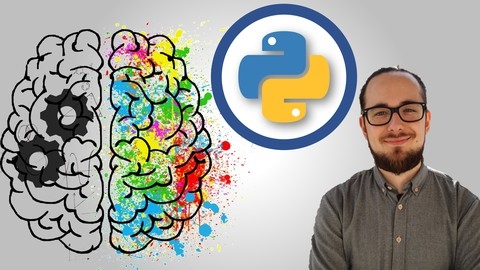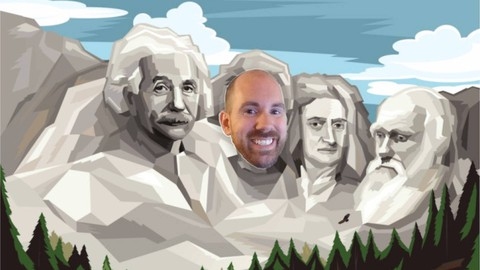Physics, the fundamental science exploring the universe’s inner workings, from the tiniest particles to the grandest galaxies, offers a captivating journey of discovery.
Understanding its principles unlocks the secrets of motion, energy, and matter, empowering you to tackle complex problems and make informed decisions across diverse fields, including engineering, medicine, and technology.
Whether you’re an aspiring scientist, a lifelong learner, or simply curious about the world around you, a solid foundation in physics provides invaluable knowledge.
However, finding the perfect physics course on Udemy can be overwhelming, given the vast array of options available.
You’re searching for a course that seamlessly blends comprehensiveness and engagement, delivered by expert instructors who cater to your learning style and goals.
You want a course that not only explains the theories but also provides practical applications and problem-solving skills.
Based on our in-depth analysis, we recommend Quantum Physics: an overview of a weird world (Basics) as the best overall physics course on Udemy.
This course provides a captivating introduction to the fascinating realm of quantum physics, guiding you through its fundamental concepts, intriguing paradoxes, and mind-bending implications.
The instructor’s clear explanations and engaging teaching style make even the most complex topics accessible and enjoyable.
But the journey doesn’t end here!
Udemy offers a wealth of exceptional physics courses catering to various interests and skill levels.
Whether you’re captivated by classical mechanics, eager to delve into the mysteries of relativity, or keen to explore the intricacies of astrophysics, we’ve got you covered.
Continue reading to uncover our curated selection of top-rated physics courses on Udemy, designed to ignite your curiosity and deepen your understanding of the universe.
Quantum Physics: an overview of a weird world (Basics)
This course guides you through the fascinating world of quantum physics, from its inception to its most perplexing paradoxes.
You begin by tracing the origins of quantum mechanics, exploring foundational concepts like the nature of light, wave interference, and the groundbreaking experiments that shook the foundations of classical physics.
You will explore phenomena like the photoelectric effect and delve into the intricacies of Bohr’s atomic model and the Compton effect.
You then journey into the heart of quantum theory, grappling with the wave-particle duality and the mind-bending implications of Heisenberg’s uncertainty principle.
This exploration leads you to the wavefunction, the Schrödinger equation, and the enigmatic world of atomic orbitals, gaining a deeper understanding of how electrons behave.
You will master the tools used to describe and understand the behavior of quantum systems, including the state vector and observables.
Prepare to dive deeper into the mysteries of the quantum realm, where you encounter concepts like spin, quantum algebra, and the perplexing commutation relations.
You will confront the philosophical implications of quantum physics head-on as you explore the profound questions surrounding the role of information in the quantum world.
Concepts like quantum entanglement, the EPR paradox, and the iconic Schrödinger’s cat thought experiment will challenge your understanding of reality.
You will even grapple with the intricacies of quantum indistinguishability and the Casimir effect, a testament to the strangeness of the quantum vacuum.
Computational Physics: Scientific Programming with Python
This course begins with the installation of Python using Anaconda and introduces you to Jupyter Notebook, a platform for coding and exploring physics concepts.
You will learn how to work with fundamental data types such as numbers, strings, lists, arrays, and matrices, which are essential for representing and manipulating data in physics.
You will then dive into writing Python code involving loops, if statements, and functions.
As you progress, you will gain proficiency in reading and writing data from files and become skilled in creating visualizations using Matplotlib, generating insightful graphs like scatter plots, line plots, contour plots, and 3D plots.
The curriculum then guides you through numerical methods such as Taylor series expansions, interpolation, and data fitting, providing you with tools to approximate functions, analyze data, and model physical events.
You will explore derivatives and integrals, implementing them through numerical methods like the trapezoidal rule and Simpson’s rule using Python.
You will be able to apply these methods to real-world physics problems, such as calculating moments of inertia for different objects, analyzing magnetic fields, and even simulating the dynamics of a rolling ball.
As you advance, you will delve into the intricacies of differential equations, learning how to solve them numerically using techniques like Euler’s method, Runge Kutta methods, and leveraging the capabilities of the SciPy library.
You will explore fascinating topics, including the chaotic behavior of Lorenz systems, the intricacies of the heat equation, and the captivating motion of celestial bodies.
You will even venture into the world of quantum mechanics, learning to numerically solve the Schrödinger equation and exploring fascinating concepts such as the Quantum Hall effect.
Along the way, you will tackle engaging projects, from simulating a magnet using Monte Carlo algorithms to understanding the unique electronic properties of graphene.
The course concludes with eigenvalue problems and the application of Fourier transforms to dissect periodic signals.
Quantum Physics from Beginner to Expert (Quantum mechanics)
This course takes you on a journey, starting with the basics of why quantum physics is important and moving into more complex theories.
You begin by understanding light, not just as a wave or a particle, but as both, a concept known as particle-wave dualism.
You then delve into the mysteries of Heisenberg’s uncertainty principle and Schrödinger’s cat, thought experiments that challenge our everyday understanding of the world.
The course then introduces the Schrödinger equation, a mathematical equation that describes how quantum systems behave.
You learn about wave functions, which describe the state of a quantum system, and operators, which are mathematical tools used to extract information from these wave functions.
You even get to solve your first quantum physics exercise, putting your newfound knowledge to the test.
But the course doesn’t stop at the theoretical.
You will also learn how to apply these concepts to real-world scenarios.
You will explore the hydrogen atom, the simplest atom in the universe, and learn how quantum mechanics explains its properties.
You’ll also gain practical experience with scientific programming using Python, a powerful tool for solving complex quantum physics problems.
This allows you to visualize and interact with the abstract theories, solidifying your understanding.
You even get a taste of the mind-blowing world of quantum computing, where you’ll explore qubits, entanglement, and the potential for building super-fast computers.
The Complete AP and College Physics Course
This course takes you from the foundational concepts of physics to the mind-blowing world of quantum mechanics.
You start by brushing up on your trigonometry skills and learning about vectors and scalars.
Then, you dive into kinematics, where you explore how objects move in one and two dimensions, including projectiles like a ball thrown across a field.
You then explore forces and Newton’s Laws, understanding the relationship between force, mass, and motion.
You learn how energy is conserved and transforms between different forms like kinetic and potential energy.
The course dives into rotational motion, explaining how objects rotate, and introduces concepts like torque and angular momentum.
You even explore gravitation, from Kepler’s laws of planetary motion to understanding how satellites orbit planets.
The course then covers fluids, heat, and thermodynamics.
You learn about the behavior of liquids and gases, including concepts like pressure, buoyancy, and flow.
You discover how heat is transferred, and explore the laws of thermodynamics that govern energy in systems.
You delve into the world of oscillations and waves, including sound waves, and discover how they interact through phenomena like interference and the Doppler effect.
The Complete Physics Course - Learn Science the easy way!
In this physics course, you will embark on a journey starting with the foundational concepts of the standard and metric systems, quickly grasping metric prefixes and mastering unit conversions.
You will then delve into the world of vectors and scalars, learning how to represent them and perform operations like addition and multiplication.
Don’t be surprised when you find yourself using trigonometry alongside the Pythagorean Theorem to unlock a deeper understanding of vectors and their application to force and motion.
The course then brings the world of motion to life with motion diagrams, teaching you to decode the secrets hidden within position vs. time and velocity vs. time graphs.
You will explore kinematics, equipping yourself with powerful tools known as kinematic equations to solve complex motion-related problems.
Freefall, a captivating manifestation of motion under gravity’s influence, will then take center stage, allowing you to apply your knowledge of kinematic equations to analyze falling objects, setting the stage for unraveling the intricacies of projectile motion.
You will then explore the fascinating realm of forces with Newton’s Laws of Motion as your guide, delving into concepts like inertia and momentum.
Free body diagrams will become your trusted allies as you learn to decipher the interplay of forces acting on objects in various scenarios, including those involving friction and inclined planes.
You will then explore the interconnected concepts of work, power, and energy, understanding how these fundamental principles govern the physical world.
Finally, you will explore the intriguing concept of momentum and its conservation.
You will learn to analyze collisions, differentiating between elastic and inelastic events, and understand how momentum is transferred during these interactions, solidifying your understanding of a concept that has profound implications in physics and beyond.
Physics - Kinematics for High School and AP Physics 1
This course launches you into the fundamentals of motion.
You begin with one-dimensional kinematics, exploring the differences between scalars and vectors, and mastering the relationships between distance and displacement, speed and velocity, and acceleration.
You will become proficient in using the UAM equations to solve problems, including those involving free fall.
Through motion graphs, you will learn to visualize the interplay between position, velocity, and acceleration.
The course then propels you into the world of two-dimensional kinematics.
You will learn to use vectors, representing motion in multiple directions, and apply this knowledge to projectile motion.
You will analyze the motion of objects projected at both horizontal and varied angles, breaking down their trajectories into horizontal and vertical components.
This analysis will equip you to confidently solve complex projectile motion problems.
The course provides ample opportunities to practice and reinforce your understanding.
Comprehensive workbooks, packed with practice problems and detailed solutions, accompany both one-dimensional and two-dimensional kinematics.
You will find yourself well-equipped to test your knowledge and learn from any missteps.
Bonus materials offer guidance on furthering your physics journey with PhysicsCourseOnline, ensuring a smooth transition to more advanced concepts.
Semiconductor Physics: Foundation in Electronics & VLSI
This course takes you on a journey into the world of semiconductors, the unsung heroes of modern electronics.
You begin by unraveling the mysteries of how these materials can act as both conductors and insulators, a characteristic that sets them apart from their conductor and insulator counterparts.
You delve into the concept of conductivity and the energy band theory, providing you with a fundamental understanding of semiconductor behavior.
Next, you explore the fascinating world of energy bands.
You learn about Bohr’s Law, which explains why energy levels in atoms are fixed.
Visualizing the energy band diagram of sodium atoms coming together to form a crystal solidifies your understanding.
You then shift focus to silicon, a key player in the semiconductor world, and dissect its energy band diagram, gaining clarity on the distinction between valence and conduction bands.
The course then introduces you to intrinsic semiconductors and the concept of electrons and holes, which are crucial for understanding how these materials conduct electricity.
Doping, a process of adding impurities to semiconductors to create N-type and P-type materials with varying conductivity levels, becomes clear.
With this knowledge in hand, you move on to the P-N junction diode, a fundamental component in electronics.
You uncover how this junction behaves under forward and reverse bias conditions, establishing the foundation for understanding countless electronic circuits.
Optics from Beginner to Expert - The Physics of Light
In this course, you embark on an enlightening journey, starting with the fundamentals of geometrical optics.
You begin by exploring reflection and the intriguing properties of mirrors.
You learn to differentiate between real and virtual images, unravel the workings of concave and convex mirrors, and even master the art of image construction.
You delve into calculations, determining image size and distance for mirrors, and grasp the concepts of focal length and optical power.
Your journey then extends to reflecting telescopes, where you witness these principles in action.
Moving on to refraction, you uncover the principles governing the behavior of light as it traverses different mediums.
You explore Snell’s law, delve into the phenomenon of total internal reflection, and understand the implications of Fermat’s principle.
You then transition to lenses, discovering the properties of convex and concave lenses, and learn to apply the lensmaker’s equation.
You also investigate the intricacies of microscopes and the human eye, gaining insight into optical aberrations, dispersion, and the captivating world of colors.
Venturing further, you encounter wave optics, where light’s wave nature takes center stage.
You delve into Huygens’ principle, a cornerstone of wave theory.
You explore wave interference and diffraction, witnessing firsthand the wonders of the double-slit experiment.
You also learn about diffraction gratings and the limits of angular resolution as defined by the Rayleigh criterion.
Polarization, another captivating aspect of light waves, is unveiled, introducing you to polarizers, birefringence, and the intriguing Brewster angle.
The course then challenges you to explore the depths of Maxwell’s equations, the foundational pillars of electromagnetism.
You learn how these equations elegantly describe light as electromagnetic waves, unraveling properties like intensity, radiation pressure, and the intriguing Poynting vector.
You delve into the derivation of Fresnel equations, gaining a deeper understanding of reflection and transmission at interfaces.
You also explore the concept of a complex refractive index and its implications for light attenuation and opacity.
Also check our posts on:







